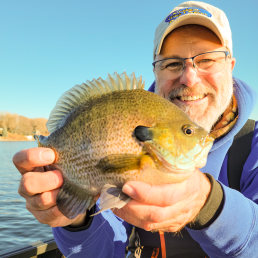All-Species, Light-Tackle Action
SHARE THIS POST
Time and time again, I’ve scaled down tackle and presentation and caught more and even bigger fish! You’d be surprised at how larger predators like walleyes, bass, pike and muskies will really go ga-ga for the small stuff. But you must be smart and not only scale down your lures, but also scale down your presentation to make it all work together.
I fish a lot of jigs in rivers all year long. Sometimes, though, picky walleyes just won’t grab a 1/4-ounce jig-n-minnow all the way—”tail biters.” I’m usually casting a 1/4-ounce BFishN Tackle 1/4-ounce H2O jig up shallower and working it back slowly, popping it and letting it slide back with the current. My rod of choice is a St. Croix Eyecon Snap Jig model; it works perfectly with 10-pound, Hi-Vis Yellow Power Pro line and a 10-pound fluorocarbon leader. I’ve caught thousands of fish this way.
Some days, though, the fish are there, but like I said… tail biters. It could be after a cold front. So, I’ll switch from my walleye rod to my St. Croix Panfish Series rod loaded with 5-pound Hi-Vis Yellow power Pro and a 6-pound fluorocarbon leader, with a lighter, smaller, 1/8-ounce H2O jig and minnow. The sensitivity of this rod is unsurpassed, and you will feel every nuance of the bottom and have one heck of a fight from any size fish you happen to catch.
I was out fishing last year with central-Wisconsin guide Justin Kohn, and we were targeting largemouth bass on pike on a shallow, weedy lake. It was right after a cold front and the fish were definitely picky. Early in the day, Justin felt that a smaller presentation would be key to getting smallmouths, largemouths and pike to bite.
The problem was that the lake was large and weedy. We still had to cover a lot of water to find the active fish, but we needed to remain weedless. So, we put AuthentX Pulse-R swimbaits on BFishN Draggin’ Jigs and made long distance casts to cover water. The 1/4-ounce Draggin’ Jig was the perfect choice when cast on 10-pound braid with a fluorocarbon leader, using a long spinning rod like a St. Croix 7-foot medium-fast Avid rod. It has the backbone and sensitivity specific to the task.
The Draggin’ Jig has a wedge head and fiber weed guard that makes it cut through the toughest weeds, which in our case was milfoil that had overtaken the lake, even in the early season. Later in summer, this lake would be virtually unfishable unless you used popping topwater frogs.
Draggin’ Jigs come in three sizes—1/4-, 1/8- and 1/16-ounce—but with the same 1/0 ultra-sharp custom hook that allows you to use the same-sized plastics with all weights. When you are fishing tight to cover, flipping the 1/16 ounce right in the thick trees or weeds will get you bass, walleyes and even catfish.
Are you enjoying this post?
You can be among the first to get the latest info on where to go, what to use and how to use it!
I like to slide on a half ‘crawler, nose-first, up to the head of the jig. The wire keeper holds the ‘crawler tight, and as you work it through cover, gives a natural presentation. I’ll also rig a minnow hook through the mouth, out the gill, and back around to mid-body. This is my go-to presentation on rivers and flowages where a lot of timber is present. It will get you all species, including giant crappies!
One last tip is to use tungsten ice jigs all year long. I like to upsize my jigs from my winter selection and use an assortment of jigs with size 8 and 6 hooks. Custom Jigs & Spins Chekais and Glazbas and my top choices, but I’ll also use the Wolfinkee, which is a heavier, Ratfinkee-style jig.
Jigs can be tipped with redworms, waxworms or small minnows, pitched up to shore and slowly reeled back. They can also be bounced on bottom or held slightly above bottom for active fish. Casting a Rocket Bobber teamed with a size 8 Glazba and redworm is a go-to presentation for giant bluegills. When using small tungsten ice jigs, I have my St. Croix Panfish rod with 5-pound Power Pro line ready-to-go for the ultimate in sensitivity.
Give some of these techniques a try this month, because when the fishing gets tough, smart anglers scale things down and use finesse approaches!
For more fishing insight from the pros who know, check out the next issue of MidWest Outdoors, available by subscribing on our website.
MWO
SHARE THIS POST
You may also like...
Nothing found.
Did you enjoy this post?
You can be among the first to get the latest info on where to go, what to use and how to use it!
Walt Matan
Walt Matan has been a writer and television host for MidWest Outdoors for 30 years. An avid ice and open-water fisherman, he currently lives in the Quad Cities on the shores of the Mississippi River. He is the product developer and brand manager for Custom Jigs & Spins, B-Fish-N Tackle, and Rippin Lips Catfish Tackle. For more information visit customjigs.com.
